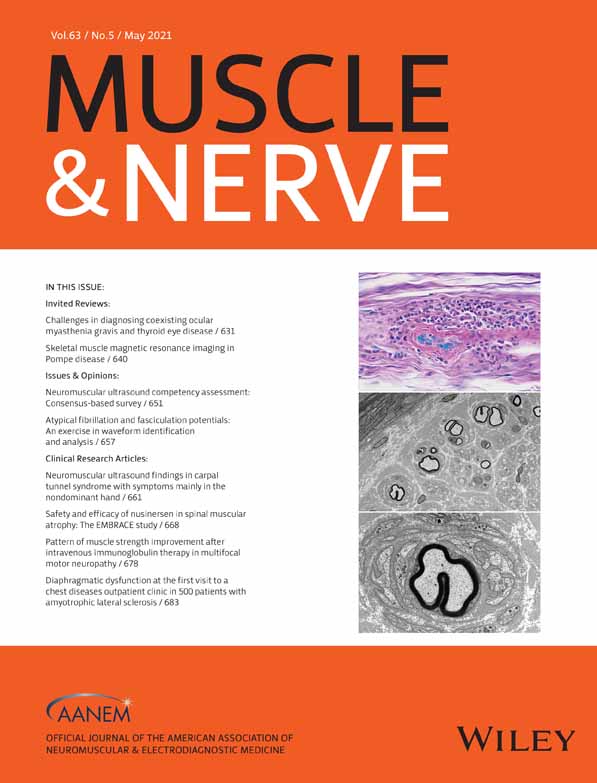Quantitative T2-mapping magnetic resonance imaging for assessment of muscle motor unit recruitment patterns
Funding information: National Center for Advancing Translational Sciences of the National Institutes of Health (NIH), Grant Number: 1R21TR003033-01A1. The contents of this article are solely the responsibility of the authors and do not necessarily represent the official views of the NIH.
Funding information: National Center for Advancing Translational Sciences, Grant/Award Number: NIH R21-TR003033
Abstract
Introduction
In this study, we aimed to determine whether muscle transverse relaxation time (T2) magnetic resonance (MR) mapping results correlate with motor unit loss, as defined by motor unit recruitment patterns on electromyography (EMG).
Methods
EMG and 3-Tesla MRI exams were acquired no more than 31 days apart in subjects referred for peripheral nerve MRI. Two musculoskeletal radiologists qualitatively graded T2-weighted, fat-suppressed sequences for severity of muscle edema-like patterns and manually placed regions of interest within muscles to obtain T2 values from T2-mapping sequences. Concordance was calculated between qualitative and quantitative MR grades and EMG recruitment categories (none, discrete, decreased) as well as interobserver agreement for both MR grades.
Results
Thirty-four muscles (21 abnormal, 13 control) were assessed in 13 subjects (5 females and 8 males; mean age, 46 years) with 14 EMG-MRI pairs. T2-relaxation times were significantly (P < .001) increased in all EMG recruitment categories compared with control muscles. T2 differences were not significant between EMG grades of motor unit recruitment (P = .151-.702). T2 and EMG score concordance was acceptable (Harrellʼs concordance index [c index]: rater A, 0.71; 95% confidence interval [CI], 0.51-0.87; rater B, 0.77; 95% CI, 0.57-0.91). Qualitative MRI and EMG score concordance was poor to acceptable (c index: rater A, 0.60; 95% CI, 0.50-0.79; rater B, 0.72; 95% CI, 0.55-0.89). T2 values had moderate-to-substantial ability to distinguish between absent vs incomplete (ie, decreased or discrete) motor unit recruitment (c index: rater A, 0.78; 95% CI, 0.50-1.00; rater B, 0.86; 95% CI, 0.57-1.00).
Discussion
Quantitative T2 MR muscle mapping is a promising tool for noninvasive evaluation of the degree of motor unit recruitment loss.
CONFLICT OF INTEREST
The authors report an institutional research agreement between Hospital for Special Surgery and General Electric Healthcare.
Open Research
DATA AVAILABILITY STATEMENT
The anonymized data that support the findings of this study are available from the corresponding author upon reasonable request.




